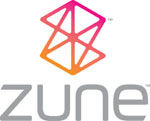Microsoft kindly loaned me a Zune player for a couple weeks to demo at some local events. There's been a lot of discussion about the interesting decisions made for this product, including the exclusion of support for Microsoft's own Windows Media DRM / Plays For Sure format for purchased music, plus the Zune's limited Wi-Fi support for sharing music for a limited period.

But I wanted to focus on the design of the player itself, and the playback experience, which is quite nice. Because of the relatively large screen for a handheld player, the Zune can be a great portable player for enjoying and sharing your own music, photos, and videos.
Zune Design
The key feature of the Zune player is the relatively large screen -- 3 in. diagonal compared to 2.5 in. for the Apple iPod video. It's also widescreen (or actually "tallscreen" -- taller than it is wider). When you play music the Zune can display the full cover art, with plenty of room underneath for a playback timeline and multiple lines of song/album/artist information. And when you play video the orientation flips sideways to take advantage of the wide screen.

As a result, the 30 GB Zune is clearly bigger then the 30 GB iPod (though closer to the 60 GB iPod model): the Zune is taller then the iPod (4.4 x 2.4 vs. 4.1 x 2.4 in.) and thicker (0.6 vs. 4.8/5.5 in.) and heavier (5.6 vs 4.8/5.5 oz.). But it's still within the upper limit of nestling comfortably in the hand.
The Zune case itself is very interesting, smooth with rounded corners. The brown unit has a subtle green tint around the front edge of the case that is more visible at different angles, and therefore somewhat disconcerting to some who see it.
The case surface is sparse, like the iPod, with the same few connectors (headphone and lock switch on the top, and computer interface on the bottom), and no break for a removable battery. There's actually more writing on the back of the iPod -- the Zune just has the logo on the back, without the "Zune" name. The Microsoft name also does not appear anywhere on the device, although tiny writing on the bottom of the back does say "Hello from Seattle."
The similarly spare controls on the front have a back (menu) button on the left, a play/pause button on the right, and a four-way control with selection button in the center. Even though the center control is round and is suggestive of the iPod's click wheel, it's just a four-way control -- up/down for volume and left/right for forward/reverse.
But there's no lettering on the Zune -- no word "Menu" like the iPod, and not even forward/reverse icons. This makes sense when you play a video and reorient the player horizontally -- the controls flip so your up/down still works as volume, and left/right to scan forward/back.
Zune Playback
The Zune starts up quickly by pressing the play/pause button -- some 10 to 15 seconds from fully off, significantly faster then my first-generation video iPod. The main menu offers Music, Video, Pictures, Radio, and Settings -- without the iPod's configurability and Extras.
The interface is familiar from other Windows Media devices and PC-based playback. Click left/right to scroll the top horizontal menu to explore your music by genres, albums, artist, playlists, or songs. Click up/down to scroll vertically though the entries, including thumbnails of album art. The display has nice smooth transitions as you jump between menus and playback, with fade and zoom effects.
Playback of music and movies is quite fast -- instant for music, and a couple seconds at most for video (again faster than the disk seek time in my first-generation video iPod).
Scanning back in forth in clips also works smoothly -- the audio cuts out for music and videos, but you do see frames as you skip forward/back though video, and playback then resumes almost instantly.
As a result, the Zune can work as a quite reasonable larger-screen player for your own collection of content.
The next step up, to something like the Creative Zen Vision gets you an even larger 3.7 in. screen and speakers so you can share your media with a group, but with more weight (8.4 oz.) and more cost ($399 vs. $249 for the Zune, both with 30 GB). Or check out the Archos 404 player, with 3.5 in. screen, but still compact at 4 x 3 x 0.6 in., weighing 6.75 oz, and $299 for 30 GB.
See more in the Portable Media Players Gallery, under Hard Disk Video Players.
